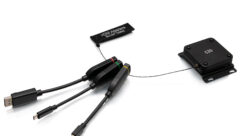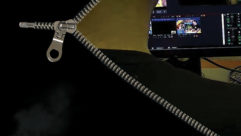
Live Streaming Basics
Oct 19, 2011 4:22 PM,
Provided by Digital Rapids
Expanding a ministry’s reach through live video streaming.

The popularity of web and mobile video offers a powerful opportunity for expanding the reach of your ministry. While on-demand (prerecorded) video is an important element of any faith-based online site, live video streaming adds the element of immediacy that can deepen the connection between you and your viewers. Live streaming, however, has a few more technical considerations that you should plan for.
One of the most common ways houses of worship are using live streaming today is to reach congregants unable to attend sermons in person. These could include ill or elderly followers, travelers, those away from their home area for an extended period (such as university students), or even those who have moved permanently from the local area but still wish to maintain their connection. Streaming technologies allow such remote worshippers to be reached on devices ranging from personal computers to mobile phones.
Another increasing use of streaming technologies is to connect multisite church organizations, enabling live sermons to be delivered across multiple gathering locations.
Related Links

Celebration Church is a model example of the multisite church, part of a growing trend made possible by AV. International House of Prayer was modernizing the congregation’s defining spiritual practice—24/7 prayer and worship—to serve a worldwide audience through a combination of live broadcast techniques and streaming….

Case Study: Simulcast for Worship
The Snell Kahuna multiformat HD/SD production switcher is playing an instrumental role at in Charlotte, N.C. …
Basic Overview of Streaming
At a basic level, there are four key steps in a typical streaming setup, with the content following a linear flow: video source –> streaming encoder –> streaming distribution server or service –> viewer
The streaming encoder is used to transform the source video signal (which may be an analog signal, such as composite, Y/C or component; or a digital signal, such as IEEE-1394 DV or SDI) into a web-friendly stream. This transformation involves compression (to “squeeze” the video and audio signals down to a data rate that can be streamed over network and Internet connections) and “wrapping” the compressed video and audio into a format and protocol used to transport the content. The church can decide what bit rate (data rate) the video streams will be compressed down to. Essentially, a larger bit rate enables higher video quality, but requires higher Internet bandwidth for both the church and viewers.
The resulting stream is sent from the streaming encoder to a distribution (streaming) server or external service (content delivery network, or CDN), from which the content is delivered to viewers. Note that in a typical situation with multiple viewers, there is generally not any “direct” connection between the viewer and the encoder—they connect only to the distribution server or CDN.
These transformations and delivery occur in realtime, so the viewer is seeing the content effectively live as it happens (although generally subject to a small delay—seconds, not minutes—incurred by the nature of network data transport).
Viewers usually access the live content through a video player embedded in a web page; the sophistication of these players varies from simple linear playback (like traditional television), to more sophisticated players with DVR-like functionality (pausing or rewinding the live streams).
A key factor in the success of the streaming is the church’s Internet (or private network) connection, which we’ll talk about in more detail in the next question, but needs to be mentioned here first.
The choice between the church using its own distribution server and using a CDN is largely based on the number of viewing locations to be reached, and the available Internet connection upload (sending) bandwidth. When using its own streaming server inside the church, the amount of bandwidth needed by the church is essentially the sum of all of the individual viewing bandwidths—the bit rate of the stream times the number of viewers. For example, if you’ve chosen a 750Kbps (note that this is kilobits, not kilobytes, per second) bit rate, and you have 100 viewers, the total bandwidth demand is 75,000Kbps (75Mbps)—far greater than the upload speeds of the majority of Internet connections, so not practical.
A CDN service provider, however, lets you scale to a virtually unlimited number of viewers, providing you’re willing to pay for that level of service. (The service cost is generally based on the amount of data transferred from your account, which will grow with your number of viewers). The church only needs to send a single stream to the CDN over its outgoing Internet connection; it’s the CDN who needs the big bandwidth to deliver to all of the viewers.
In contrast, if you are only streaming to a small number of locations, using an inhouse streaming server may be effective. For example, if the goal is to stream to two other campuses within a multisite organization, and the chosen data rate is 3Mbps, then the total outgoing bandwidth demand is 6Mbps, which is possible with a sufficiently fast connection (more on that again shortly). Note that we’ve used a higher data rate in this example on the assumption that the streams will be displayed on large TVs or monitors in this scenario, so it’s important to maximize the resolution and quality of the streams being delivered.
Note that in the case of a single viewing location—such as an output stream being transmitted to a single remote location in the case of a two-site church—the streaming server or CDN may not be necessary, as a one-to-one connection could be formed between the receiver (player) and the encoder. This is not, however, the scenario that most churches will face when they begin streaming.
The source to the encoder could be as simple as the output of a single video camera, or could be an output feed from a complete production environment (with multi-camera switching, etc.). Many churches already have such a production environment from which the encoder can receive a feed.
Live Streaming Basics
Oct 19, 2011 4:22 PM,
Provided by Digital Rapids
Expanding a ministry’s reach through live video streaming.
Technical Considerations for Success
One of the first considerations is ensuring an adequate Internet connection to send your live stream from your church. As discussed above, the bandwidth requirements for the Internet connection will depend on the deployment model, specifically whether an inhouse distribution server is being used (to reach a small number of affiliated sites) or a CDN (to reach a virtually unlimited number of viewers). To recap, in the case of the in house server, the amount of sustained upload bandwidth needed by the church is essentially the bit rate of the stream times the number of locations being streamed to. When using a CDN, there’s essentially only one location being streamed to (the CDN), with the CDN effectively replicating the stream for distribution to an almost unlimited number of viewers. Please see the examples above.
In either case, the bit rate you choose for streaming is an important factor. As above, a higher bit rate enables potentially higher quality, but requires more bandwidth on both the sending and viewing sides. A 3Mbps stream at 1280×720 high definition resolution will have higher perceived quality than a 1.5Mbps stream at the same resolution, but it requires each viewer to have 3Mbps receiving bandwidth—not unreasonable for tech-savvy viewers, but likely too high for the broad audience that you’ll probably want to reach—and the church to have at least 3Mbps sending bandwidth even if using a CDN.
If you’re streaming between gathering sites, a high bit rate and resolution will probably be worthwhile, as it’s likely that the stream will be viewed on a large monitor by multiple people. Low resolution, low bit-rate streams that look fine at small size in a window on a PC may look horrible when viewed full-screen on a large monitor or TV.
Note that it’s very important to distinguish the upload (outgoing) speed of the church’s Internet connection from the download (incoming) speed. When Internet Service Providers promote the speed of their service, the number they’re citing is generally the download speed—and on all but the highest-end offerings, the upload speed is significantly less. For example, a service provider local to us offers a service package with 12Mbps download speed, but the upload speed is only 1Mbps. While download speed is important to the viewers, it’s the upload speed that is important to the church when choosing an Internet connection, since the video is being sent out. Such a 1Mbps upload speed would be insufficient for the HD or high-bitrate systems mentioned above, but quite adequate for 640×480 standard-definition stream. (Note that since computer monitors use square pixels, NTSC video at 720×480 non-square pixels becomes 640×480 for streaming).
Ideally, the Internet connection used for sending the streaming video should be separate from the general Internet connection that the church uses for other tasks such as e-mail, web browsing and other uses. Sharing an Internet connection between the outgoing streaming and other tasks can result in unexpected performance drops as the various tasks contend for bandwidth. A dedicated line ensures that the outgoing stream isn’t affected by any other Internet activity at the church.
Live Streaming Basics
Oct 19, 2011 4:22 PM,
Provided by Digital Rapids
Expanding a ministry’s reach through live video streaming.
Common Mistakes
There are a number of subtleties that can cause issues for those first starting streaming.
1. Upload vs. download speeds of Internet connections
The upload speeds are typically much lower, but many people don’t realize that.
2. Using the same Internet connection for streaming that is used for other church tasks that may be going on at the same time.
3. A misconception we hear occasionally is that if you’re just create a small, low-bit-rate output for the Web or mobile phones, you can get away with using a lower-quality source signal (e.g. “noisy” video, lower-quality connections, etc.). In fact, the opposite is true—low-quality sources have a lot of video noise, etc., that makes the video harder to compress, and you’re wasting bits compressing the junk in addition to the content. In a low-bit-rate output, those wasted bits are a higher percentage of the total, so you can end up with a LOT lower quality output than if the source had been “clean”. You should always use the best quality signal possible, starting at the camera itself—lower-end cameras can introduce noise into the video signal, and lighting is also a big factor in compression quality. Video shot in low light has considerably more video noise than well-lit video; low-light video that looks OK on a monitor connected directly to the camera can look considerably worse once compressed for streaming. For connectivity, SDI digital signals are ideal. For analog video, component signals are the best, followed by Y/C and composite. The best encoding/streaming hardware cards and systems can also do a lot to help “clean up” the video. For example, the Digital Rapids hardware cards that all of its solutions are built on feature advanced video preprocessing, which grooms the input signal to be more compression friendly by removing video noise, providing higher-quality de-interlacing than software algorithms typically allow, and more. The result is that such systems can produce high-quality output even when the input signal is less than ideal but fantastic quality with a good source.

320×180 @ 256Kbps displayed at 200% size

640×360 @ 256Kbps displayed at 100% size
4. There’s a trade-off between visual quality and your choices of resolution and bit rate. A common mistake is to decide to stream at higher resolution (frame size) with the expectation that it will provide better quality (just like high-definition television is better quality than standard-definition). The problem is that a larger size requires more compression to get down to a specific bit rate; so the resulting visual quality may be much lower than smaller size at same bit rate. A visual example is useful: As you can see from the example images, particularly with low bit rates, streaming at a lower resolution can actually give better quality than streaming at higher resolution at the same bit rate. If you want to increase your resolution, you likely need to use a higher bit rate to accommodate it.
5. That leads to another possible mistake, though: choosing too high a bit rate. As discussed earlier, the church’s Internet connection must be fast enough to deliver streams at your chosen bit rate. Even if the church’s connection is fast enough, however, you need to make sure that the bit rate isn’t too high for your viewers. If your bit rate exceeds the sustainable bandwidth of a viewer, it’s likely to result in an unwatchable experience (lots of buffering, stuttering, skipping, etc.). Be sure to offer a stream with low enough bit rate for the “minimum” connection you expect of your viewers. In fact, it may be best to consider offering streams at multiple bit rates—at least one for those with slow connections, and a high-quality stream for those with fast connections. Some encoders, such as Digital Rapids’ TouchStream and StreamZ, can output multiple streams at various resolutions and bit rates simultaneously from the same source signal. But remember that if the church is offering a choice of multiple streams, its Internet connection must be fast enough to send those streams out together—at least as fast as the sum of the bit rates of the streams. For example, if you’re offering a 384Kbps stream and a 768Kbps stream, your outgoing Internet connection must be at least 1152Kbps.
6. Last but not least, don’t forget that even though your streams aren’t Hollywood blockbusters or paid commercial programming, video quality likely still matters to your audience. As technology has advanced, audience expectations have also increased. And it’s much easier for a viewer to focus on the message when they aren’t distracted by quality issues in the delivery mechanism (video).
Live Streaming Basics
Oct 19, 2011 4:22 PM,
Provided by Digital Rapids
Expanding a ministry’s reach through live video streaming.
Going Further
With the growing popularity of mobile devices such as the Apple iPhone, churches should consider streaming to not just computers on the Web but also mobile phones. PC-based video players and mobile phones typically require different streaming formats, resolutions, and bit rates, so separate streams must be generated for each. Fortunately, the most flexible encoding systems enable the simultaneous live creation of multiple formats for reaching multiple devices.
Last but not least, make sure that your live streaming system also allows you to save the live streams as files that can later be put on your website for on-demand viewing. That allows your congregants who couldn’t view the sermons live to access them later at their availability. While most CDNs offer the ability to save the streams to files on their servers as part of their service, advanced encoders that allow you to do so locally onto your hard drive (such as TouchStream) enable you to create the file copy at higher resolution, bit rate, and quality than you’re actually streaming to the CDN—ideal if you plan further postproduction (editing, etc.) or reproduction (publishing to DVD, etc.) of the content.









